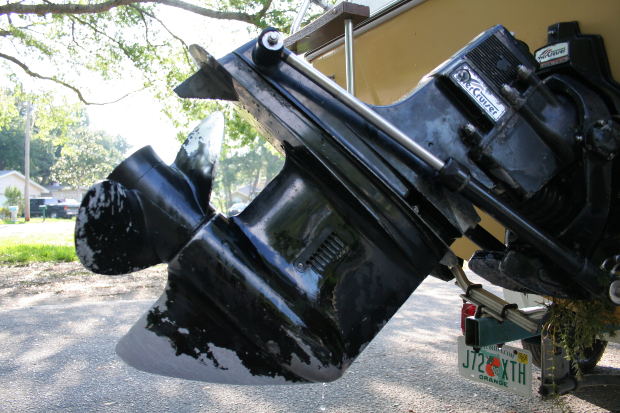I'm going to say this before anything else. I STRONGLY urge you to get this thing to a qualified marine mechanic. However, you are here and posting so that means you've probably already considered that and you are trying to save yourself some money and see if you can figure it out on your own. And there's nothing wrong with that, but in order for us to help you (if we can) there are a few things to get figured out first. This will seem pretty complicated as you learn, but Google and boards like this are your friend for sure.
First, you need to learn a *little* bit of terminology. Anything that comes out of the back of the boat above the drain plug is referred to as the boat's outdrive. The part of the boat where the drain plug is (and the part to which the outdrive and its housing are mounted) is called the transom. The outdrive is mounted to the transom, and will be one of two kinds: Volvo or Mercruiser.
Which outdrive do you have?
A Volvo?

Or a Mercruiser?

The images may not be a perfect match, but Volvo is generally gray colored and a Merc is generally black.
Once you ID that for us, tell us where the water is coming out. Is it coming out from the outdrive housing that is mounted to the transom? If so, that is totally normal because that is the water that has cycled through the engine for cooling purposes and is now being discharged so that new fresh water can be taken into the engine to continue cooling the engine. Once you figure that out (or verify it for us) that should put you at ease.
Second, if you are ever going to run the boat out of the water, you MUST use a garden hose and an attachment to hook to the lower part of the outdrive to get water into the motor to keep it cool. It will look something like this:
On the shelf at local store or on website you use:

Where to hook boat with hose:

It goes on those slotted-looking holes-there is a set of them on each side of the lower half of the outdrive. This part of the outdrive (near the prop) is called the lower unit. These are raw water intake holes and they suck water in to cool the engine.
Now, to your weekend issues. You will somehow need verify that you sealed the hole correctly. What material did you use? How do you know it isn't leaking? Are you confident enough in your ability to remove your repair and re-do it if you discover that the material you used was insufficient or that the repair area is leaking?
The fact that you left it in the water for a week and came back to it being fine (no water in engine compartment) *MIGHT* (
I STRESS *MIGHT*) indicate that it was sufficient. However, the fact that you had a boat full of water after using it suggests that the sealing of the hole might not be very good when the boat is moving. Maybe it is good enough to only hold while sitting but not while underway?
Another possibility is a hose that is leaking water into the engine compartment with the boat running. The best way to find this out is on dry land using the garden hose attachment above. Make sure you have the tiny holes down by the propeller covered and the hose turned on fully. DO NOT PUT IT IN GEAR. Just run it in neutral. With it running on dry land, closely observe the engine compartment for leaks. Run it with the transom plug in so that any leak will accumulate. If you leave the transom plug out, it may be confusing whether the water you're seeing back there is coming out of the transom plug (which means the water is draining from inside the boat) or whether it is just the normal discharge water.
Another possibility is a torn/crack bellows in the outdrive. This bellows lives inside of the outdrive and it is what keeps water away from the driveshaft and/or the exhaust tube when the outdrive is moved up or down. It flexes as the outdrive moves. Without knowing your equipment, it is pretty difficult to know what yours has specifically. But the main info to know is that a bellows gets cracked and can tear just with mere age. If they are the originals on this 20 year-old boat, they are suspect. If your engine running test does not ID a leak in the engine compartment, this is where I'd be looking next if I were you. And given your limited boat knowledge/experience, I'd let a mechanic handle this repair if I were you. Tough to say whether this is your problem. If the bellows were already torn you'd have probably discovered lots of water when you arrived to use the boat. However, you could have torn it while using it (not through any fault of yours but merely BECAUSE BOAT) and would have no way to know until water starts to leak in.
Final possibility is that you have a leak AT the transom where the outdrive assembly is mounted to the transom. I'd only suspect this after eliminating the other 3 possibilities above.
Give us some more info and we will try to help you as best we can. Lots of sharp guys on this forum.



